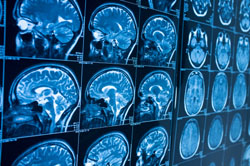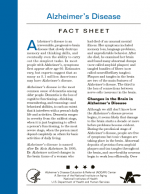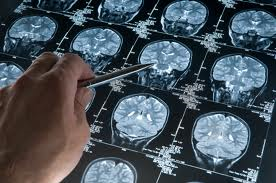A key component of the Federal research program for Alzheimer’s disease is to create and sustain an infrastructure that supports and enhances scientific discovery and translation of discoveries into Alzheimer’s disease prevention and treatment. NIA’s coordinating mechanisms and key initiatives are central to this effort. Specifically, important advances are being made by supporting high-quality research, from which data can be pooled and shared widely and efficiently through a well-established Alzheimer’s disease research infrastructure.
This infrastructure and initiatives described in this report seek to bring together researchers and Alzheimer’s interests by:
- Convening and collaborating in workshops addressing new scientific areas
- Working across NIH to vigorously discuss new science and opportunities for new investment
- Partnering with other Federal agencies, not-for-profit groups, and industry in the shared goals of improved treatments, new prevention strategies, and better programs for people with Alzheimer’s and their caregivers.
Infrastructure
 NIA Intramural Research Program (IRP). In addition to funding a broad portfolio of aging-related and Alzheimer’s research at institutions across the country, NIA supports its own laboratory and clinical research program, based in Baltimore and Bethesda, MD. The NIA IRP focuses on understanding age-related changes in physiology and behavior, the ability to adapt to biological and environmental stresses, and the pathophysiology of age-related diseases such as Alzheimer’s.
NIA Intramural Research Program (IRP). In addition to funding a broad portfolio of aging-related and Alzheimer’s research at institutions across the country, NIA supports its own laboratory and clinical research program, based in Baltimore and Bethesda, MD. The NIA IRP focuses on understanding age-related changes in physiology and behavior, the ability to adapt to biological and environmental stresses, and the pathophysiology of age-related diseases such as Alzheimer’s.
Laboratory research ranges from studies in basic biology, such as neurogenetics and cellular and molecular neurosciences, to examinations of personality and cognition. The IRP also conducts clinical trials to test possible new interventions for cognitive decline and Alzheimer’s disease. The IRP leads the Baltimore Longitudinal Study of Aging (BLSA), America’s longest-running scientific study of human aging, begun in 1958, which has provided valuable insights into cognitive change with age.
The IRP’s Laboratory of Behavioral Neuroscience is identifying brain changes that may predict age-related declines in memory or other cognitive functions. Using brain imaging techniques, such as magnetic resonance imaging (MRI), which measures structural changes, and positron emission tomography (PET) scans, which measure functional changes, IRP researchers are tracking memory and cognitive performance over time to help identify both risk and protective factors for dementia. For example, an IRP study involving more than 500 BLSA participants uses brain imaging, biomarkers, and cognitive assessments to track changes in cognitive function in people who do not develop Alzheimer’s and in those who develop cognitive impairment and dementia.
Additionally, IRP researchers help identify potential drug targets for Alzheimer’s disease. They screen candidate drugs for efficacy in cell culture or animal models. The most effective compounds are moved through preclinical studies to clinical trials. IRP researchers also collaborate with academia and industry to develop agents that show promise as an Alzheimer’s intervention. Industry has licensed patents covering a variety of novel compounds from NIA for preclinical and clinical development.
Alzheimer’s Disease Centers (ADCs). NIA’s ADCs form the backbone of the national Alzheimer’s disease research effort. These multidisciplinary centers, located at 27 institutions nationwide, promote research, training and education, and technology transfer. Thanks to the participation of people in their communities, the Centers conduct longitudinal, multi-center, collaborative studies of Alzheimer’s disease diagnosis and treatment, age-related neurodegenerative diseases, and predictors of change in people without dementia that may indicate the initial stages of disease development.
The ADCs also conduct complementary studies, such as imaging studies and autopsy evaluations. All participants enrolled in the Centers receive a standard annual evaluation. Data from these evaluations are collected and stored by the National Alzheimer’s Coordinating Center (NACC; see below) as the Uniform Data Set. The ADCs serve as sites for a number of major studies, such as national clinical trials and imaging and biomarker research.
Alzheimer’s Disease Translational Research Program: Drug Discovery, Preclinical Drug Development, and Clinical Trials. NIA has a longstanding commitment to translational research for Alzheimer’s disease. In 2005, the Institute put this effort into high gear by launching a series of initiatives aimed at supporting all steps of drug discovery through clinical development. The goal of the program is to seed preclinical drug discovery and development projects from academia and from small biotechnology companies and, in doing so, to increase the number of investigational new drug candidates that can be tested in humans.
This strategic investment has led to the relatively rapid creation of a large, diverse portfolio of projects aimed at discovery and preclinical development of novel candidate therapeutics. To date, NIA has supported more than 50 early drug discovery projects and 18 preclinical drug development projects through this program. Fifteen of the 18 preclinical drug development projects are for compounds against non-amyloid therapeutic targets, such as tau, ApoE4, pathogenic signaling cascades, and neurotransmitter receptors. Four of these projects have advanced to the clinical development stage.
This program supports outreach and education activities held at regular investigators’ meetings and at an annual drug discovery training course organized by the Alzheimer’s Drug Discovery Foundation. These meetings provide much-needed networking opportunities for NIA-funded investigators and industry and regulatory experts, as well as education of a new cadre of academic scientists.
Two major program initiatives in translational research and clinical trials are:
- Alzheimer’s Disease Pilot Clinical Trials Initiative. This initiative, begun in 1999, seeks to increase the number and quality of preliminary clinical evaluations of interventions for Alzheimer’s, MCI, and age-associated cognitive decline. These trials are investigating drug and nondrug prevention and treatment interventions. The goal is not to duplicate or compete with the efforts of pharmaceutical companies but to encourage, complement, and accelerate the process of testing new, innovative, and effective treatments. The National Institute on Nursing Research, part of NIH, also participates in this initiative. See “Testing Therapies to Treat, Delay, or Prevent Alzheimer’s Disease” to learn more about the trials and to see a complete list of treatment and prevention trials.
- Alzheimer’s Disease Cooperative Study (ADCS). NIA launched the ADCS in 1991 to develop and test new interventions and treatments for Alzheimer’s disease that might not otherwise be developed by industry. Currently operated under a cooperative agreement with the University of California, San Diego, this large clinical trials consortium comprises more than 76 sites throughout the United States and Canada. The ADCS focuses on evaluating interventions that will benefit Alzheimer’s patients across the disease spectrum. This work includes testing agents that lack patent protection, agents that may be useful for Alzheimer’s but are under patent protection and marketed for other indications, and novel compounds developed by individuals, academic institutions, and small biotech companies. The ADCS also develops new evaluation instruments for clinical trials and innovative approaches to clinical trial design. Since its inception, the ADCS has initiated 32 research studies (25 drug and 7 instrument development protocols.) The ADCS also provides infrastructure support to other federally funded clinical efforts, including the Alzheimer’s Disease Neuroimaging Initiative (ADNI) and the Dominantly Inherited Alzheimer Network (DIAN). (Read more about these studies below.)
National Alzheimer’s Coordinating Center (NACC). NIA established NACC in 1999 with the goal of pooling and sharing data on participants in ADC studies. By 2005, NACC had collected data from some 77,000 ADC study participants, including neuropathological data from 10,000 brain autopsies. NACC then added clinical evaluations and annual follow-ups to its protocol, enriching the database with detailed longitudinal data from 26,500 participants and 2,100 brain autopsies. The data are available to Alzheimer’s researchers worldwide.









